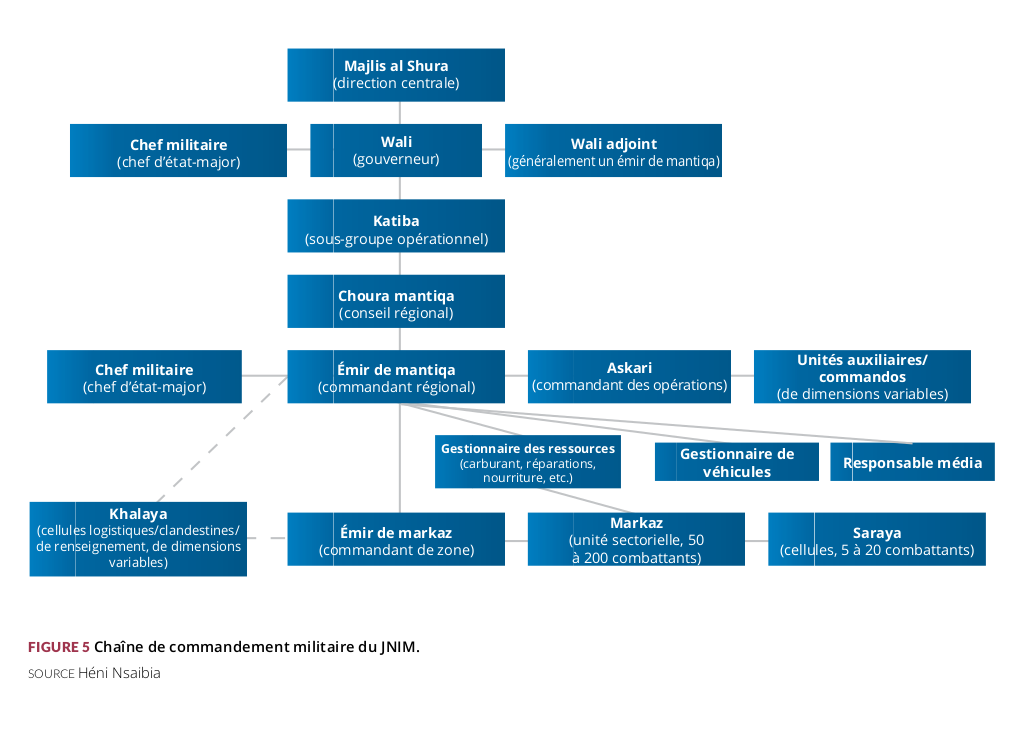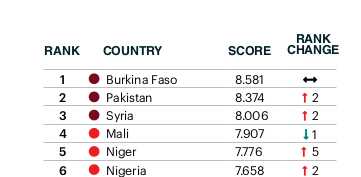Date : 24 Apr 2025
JNIM in the Sahel: Recent Developments and Area of Influence
JNIM is one of the most influential Islamist terrorist organizations in the world. As of 2025, this conglomerate of jihadist groups has never appeared more dangerous.
Jama’at Nusrat al-Islam wal-Muslimin (JNIM), or the Group for the Support of Islam and Muslims (GSIM), is a coalition of radical Islamist factions designated as a terrorist entity by the United Nations. It is one of the deadliest threats in the central Sahel. The group was established in early March 2017 through the merger of four armed factions: Al-Qaeda in the Islamic Maghreb (AQIM), Ansar Dine, Al-Mourabitoun, and the Macina Katiba. Over the years, these jihadist armed groups have effectively unified, forming a complex and versatile terrorist organization with ambitions of dominating the central Sahel.
In the years following its formation, JNIM positioned itself as a “unifying alliance,” aiming to attract a wide range of local communities and ethnic groups. To this end, the group launched extensive media operations to recruit among Tuareg, Arab, Fulani, Songhai, and Bambara populations. According to a Berghof Foundation report, one expert noted: “During its early years, Ansar Dine communicated very little, but since JNIM’s creation, they have a new media agency and are producing a lot.” Through this strategy, the jihadist group has managed to expand its influence among the Dogon in the Dogon Country and the Séno-Gondo plain, the Minyanka in the Sikasso region, and even among Mooré- and Bissa-speaking communities in various parts of Burkina Faso. As a result, the jihadist entity has become a multi-ethnic mosaic. To organize these diverse networks, Iyad Ag Ghaly—a Tuareg political figure and founder of Ansar Dine—was appointed as JNIM’s supreme leader. This nomination reflects the group’s intent to deepen its local roots and increase its power and influence across the central Sahel.
Within this framework, JNIM’s ideology and objectives serve as a unifying force among its various ethnic communities and affiliated terrorist groups. Its members share a decontextualized interpretation of the Qur’an and aim to spark a social revolution against perceived domination structures within communities, with the ultimate goal of enforcing Sharia law. Jihad, traditionally referring to struggle and self-sacrifice, is violently manipulated by JNIM to serve its political objectives. Beyond that, JNIM works to expand its networks across the Sahel to assert hegemonic control and achieve regional supremacy as a non-state armed actor. In doing so, the group confronts regional governments to impose an alternative jihadist social and political order in the central Sahel. Even prior to its official creation, JNIM’s constituent groups were already engaged in fighting against regional governments—for instance, AQIM’s predecessors battled Algerian forces during the civil war, while Ansar Dine launched a series of attacks against the Malian government in 2012.
A flexible yet structured organization

To achieve its political objectives, JNIM seeks to implement a form of governance over local populations. By asserting itself as a ruling authority, the Sahelian jihadist group works to regulate civilian behavior, focusing on the provision of services and control of the local economy. This objective is nothing less than the materialization of its ambition to form a proto-state. Consequently, JNIM has adopted a pyramidal internal structure, organized into three levels: the upper level, led by the Shura Council, which sets the overall strategic direction, ensures cohesion among factions, and coordinates with other Al-Qaeda-affiliated groups; the intermediate level, with a regional consultative council making major decisions at the regional scale; and the lower level, which manages field operations. This three-tiered structure is essential as it enables internal oversight and a chain of command structured by military cadres.
Contrary to what one might think, JNIM is not a disordered collection of Islamist factions. Since its inception, the group has cultivated a strong identity to which members at all levels are deeply committed, making JNIM particularly resilient. To maintain this cohesion, a delicate balance between centralization and decentralization has been designed. Indeed, the Shura Council remains central in major decision-making. However, regional commands at different levels (katiba, mantiq, marakz, saraya) retain significant autonomy in their daily activities.
A prolific territorial presence
Thanks to its protean organization and different branches, JNIM is deeply rooted in the Sahel while remaining a highly mobile organization. At its creation, the terrorist group controlled only a few scattered areas of territory in the north, center, and south of the country. Today, JNIM is present across vast territories. In Mali, the terrorist group has consolidated its grip in the regions of Kidal, Gao, Tombouctou, Gao, and Mopti, and has extended its presence around Bamako and Kayes. In this context, JNIM crosses borders, being very active in Burkina Faso and the southern part of Niger in the Tillabéri region. Simultaneously, JNIM is working to gain ground in the north of Benin, Togo, and Ivory Coast in order to approach the Gulf of Guinea. According to Abdou Khadir Cissé, an expert on violent extremism in West Africa, this expansion is part of a "strategy to go beyond the comfort zone of the Central Sahel. [...] The group seeks to move away from the military pressure exerted by regular armies, which have recently equipped themselves with significant resources." More factually, for JNIM, the route to the Gulf of Guinea signifies access to logistical resources, which are crucial for armed struggle.
Indeed, besides confrontations with regular armies, JNIM is in conflict with a rival terrorist group: the Islamic State in the Greater Sahara (EIGS). Tensions between the two jihadist groups escalated at the end of 2017, when their desire to expand southward to form a proto-state came into competition. To achieve this goal, JNIM relies on the porous borders to build local alliances. This approach contrasts with that of EIGS, which aligns with the violence and brutality of its parent organization: the Islamic State. The growing animosity between JNIM and EIGS has led to a territorial war in the Liptako-Gourma region, also known as the "three borders" area. Spanning Mali, Niger, and Burkina Faso, this zone has now become the epicenter of global terrorism. While EIGS uses eastern Burkina Faso as a rear base, the "three borders" area is frequently crossed by these groups, making them particularly elusive for local armed forces. Since 2023, the route south, passing through the borders between Niger, Benin, and Nigeria, has been at the center of tensions between JNIM and EIGS. This territorial conquest is crucial for the continuation of operations by these groups, as it provides opportunities for recruitment and access to resources from surrounding villages.
The financial tentacles of JNIM
However, it is important to note that some of the lucrative activities sustained by JNIM have the potential to undermine the livelihoods of local populations. Yet, for JNIM, these populations play a central role in its strategy for partnership and expansion. Artisanal gold mining is one of the primary sources of funding for JNIM. The jihadist group exerts pressure on small-scale artisanal gold mining sites or on transport routes. Through these controls, the group exploits local populations. This is evident in the N’Abaw gold basin, located southwest of Gao, on the border with Burkina Faso, where two thousand miners work under the control of JNIM. Furthermore, jihadists from the same entity organize payments in the form of zakat (charitable donations) in exchange for protection.
This practice extends to the collection of various goods, but most notably to cattle theft. Cattle represent a significant resource, the importance of which varies depending on the area and the degree of infiltration by the jihadist group. In the territories it controls, JNIM positions itself as the arbiter of disputes concerning cattle. In reality, jihadists seize the cattle at the origin of the disputes. In 2021, the group managed to generate 440 million CFA francs from cattle thefts.
More seriously, kidnappings are also a preferred means of financing for JNIM. In its first year, it is estimated that JNIM raised between 18 and 35 million dollars, with 40% of that amount coming from ransoms for its abductions. Additionally, JNIM uses kidnappings as a strategic tool. To support its expansion and solidify its areas of influence, the terrorist group kidnaps local figures and leaders. For example, religious leader Amadou Hady Tall was abducted last December because he was accused of supporting the Malian state and had encouraged young jihadist recruits to lay down their arms. According to several media outlets, the religious leader is believed to have passed away, which reflects the intensification of JNIM's violence, particularly against profiles that had previously been spared.
JNIM more bloodthirsty than ever

According to the 2025 Global Terrorism Index, compiled by the Institute for Economics & Peace, JNIM is one of the four terrorist groups responsible for the most deaths worldwide last year. For the Sahelian terrorist organization, 2024 was a record year. During this year, JNIM attacks resulted in the deaths of 1,454 people, representing a 46% increase. Additionally, according to the report, JNIM attacks had the highest lethality rate, with an average of 10 deaths per attack. In this regard, JNIM is responsible for the second and third deadliest attacks of the previous year. The deadliest took place on August 28, when dozens of armed men killed between 200 and 600 civilians in the town of Barsalogho in Burkina Faso. A few weeks earlier, 110 soldiers were also killed and 60 civilians abducted during an attack on a military base in the commune of Mansila, in the Yagha province, also in Burkina Faso. The repercussions on the civilian population are immense. In 2024, the number of civilian victims doubled compared to the previous year. In 2023, 343 civilians were killed in JNIM attacks, while 761 died in the past year. Thus, in 2024, 67% of the victims were civilians. The intensification of JNIM attacks forces local governments to adjust their military responses accordingly. However, the sprawling nature of the Islamist organization forces states to address socio-economic issues, which often drive the engagement of new jihadist recruits. As a result, the security situation in the countries of the central Sahel is critical. The 2025 Global Terrorism Index ranks Burkina Faso as the country most affected by terrorism, while Mali (4th) and Niger (5th) complete the Top 5.